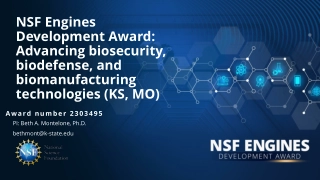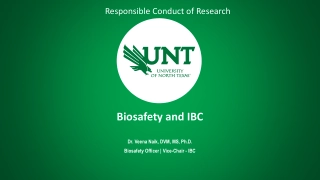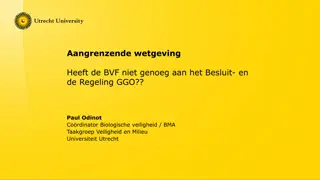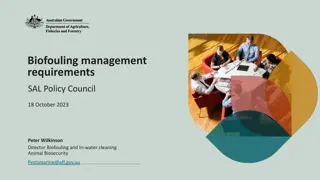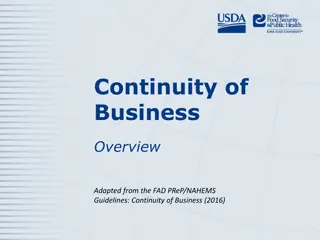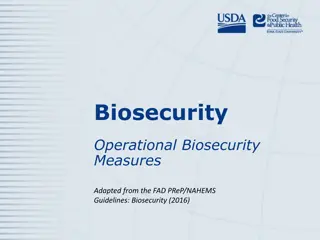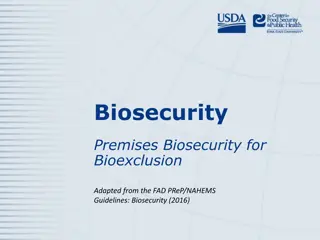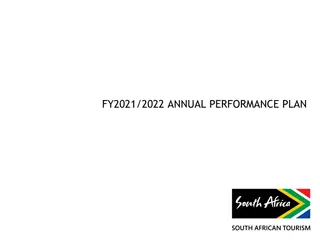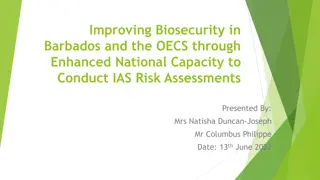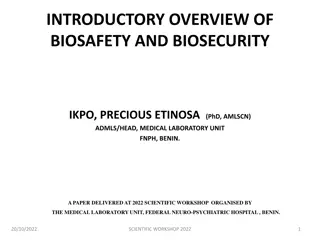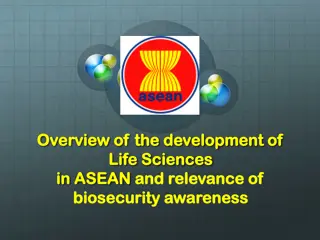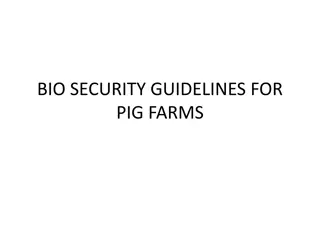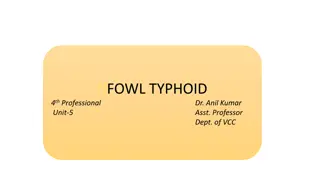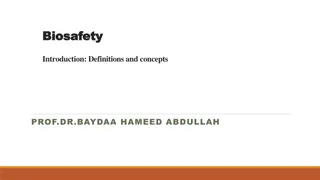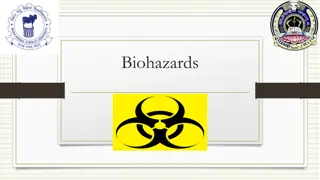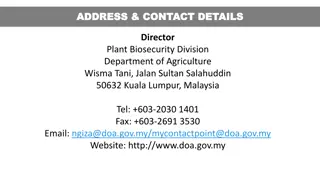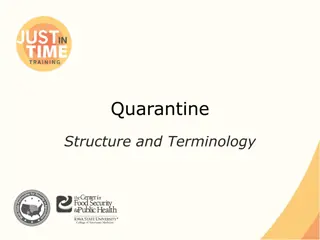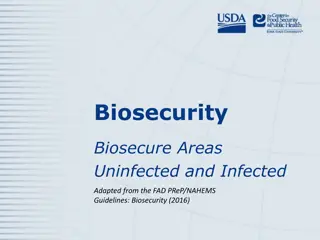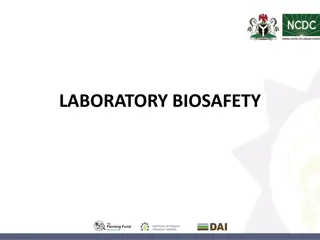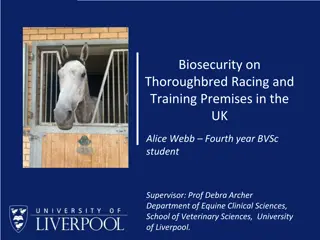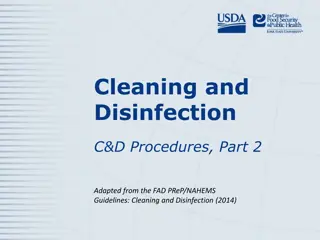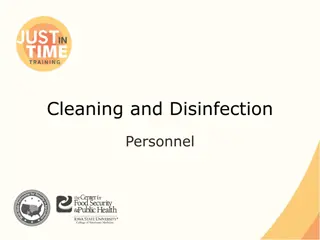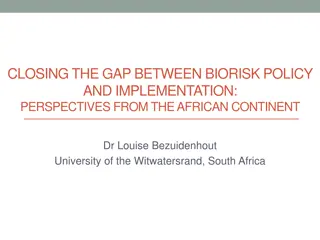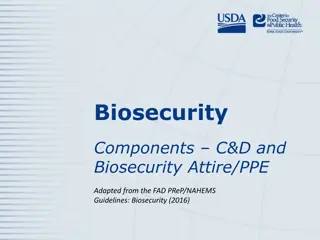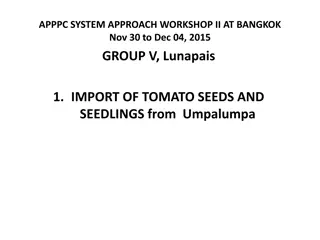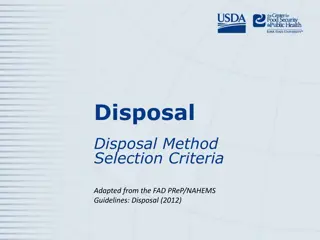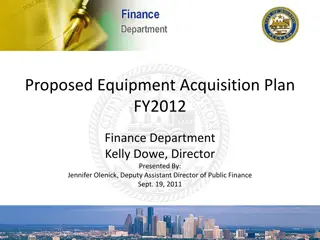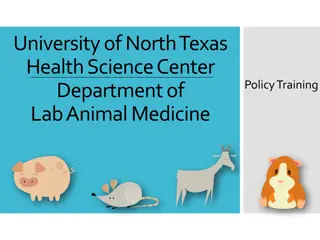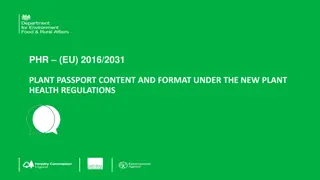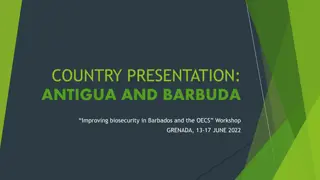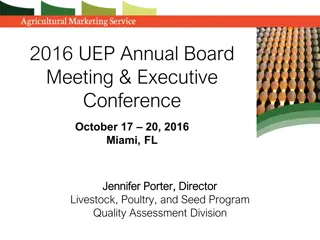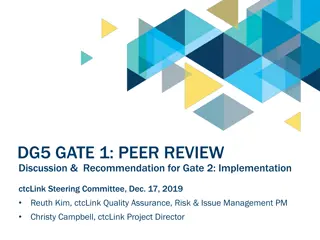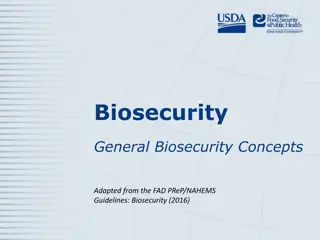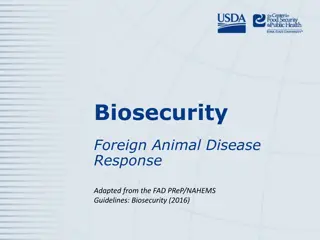Advancing Biosecurity and Biomanufacturing Technologies in the KS-MO Region
NSF engines development award to foster diverse regional coalitions and stimulate R&D and economic growth in biosecurity, biodefense, and biomanufacturing. Enhancing use-inspired research, commercialization, and workforce development to attract companies and capital.
2 views • 9 slides
A Risk Factor Study on Food Establishments in Kansas
Explore a risk factor study conducted on food establishments in Kansas by Crystal Futrell, a Kansas State University MPH candidate specializing in Food Safety and Biosecurity. The study delves into the history of the Kansas Department of Agriculture, its various programs related to food safety and l
0 views • 68 slides
Biosafety and IBC - Understanding Research Conduct and Safety Measures
Explore the essential aspects of biosafety and the role of Institutional Biosafety Committees (IBC) in ensuring responsible research conduct. Learn about biohazards, biosecurity, laboratory-acquired infections, routes of exposure, and the structure and functions of the IBC. Enhance your understandin
1 views • 13 slides
Avian Influenza Overview and Outbreak History in South Africa
Avian Influenza, specifically Highly Pathogenic Avian Influenza (HPAI) outbreaks in South Africa, have been documented since 2004, affecting primarily ostriches and poultry. Wild bird transmission remains a concern, with risk factors such as rainfall, temperature, wetlands, and poultry movements con
2 views • 25 slides
BVF and Adjacent Legislation: Understanding the Regulatory Landscape
Exploring the broader regulatory framework surrounding Biologische Veiligheid en Functiebescherming (BVF), this content delves into a range of legislation intersecting with BVF activities, such as Arbo regulations, transportation of hazardous substances, biosecurity protocols, and more. These adjace
4 views • 22 slides
Australia's Biofouling Management Requirements Update
Australia's Department of Agriculture, Fisheries and Forestry has implemented phased biofouling management requirements to enhance marine biosecurity. The update includes new enforcement measures, mandatory pre-arrival reporting, and education phases to ensure vessels comply with biofouling regulati
2 views • 5 slides
Comprehensive Overview of Continuity of Business in FAD Outbreaks
Continuity of Business (COB), also known as managed movement, is a crucial strategy that allows the movement of non-infected animals and non-contaminated animal products during a Foreign Animal Disease (FAD) outbreak. This approach helps maintain normal business operations in agriculture and food in
4 views • 27 slides
Enhancing Biosecurity Measures for Livestock Operations
This presentation explores operational biosecurity measures adapted from FAD PReP/NAHEMS Guidelines, emphasizing the importance of developing an effective biosecurity plan to prevent disease spread. It discusses the three levels of biosecurity, operational processes, and procedures for personnel, ve
0 views • 25 slides
Best Practices for Premises Biosecurity in Production Facilities
Operational recommendations for maintaining biosecurity in production facilities, focusing on bioexclusion and daily management. The guidelines cover the implementation of effective procedures, assigning responsibility and authority, role of a biosecurity officer/manager, training personnel, and ens
0 views • 26 slides
Tourism Sector Recovery Plan for FY2021/2022
The Tourism Sector Recovery Plan for FY2021/2022 focuses on implementing strategic interventions to revive the tourism sector in South Africa following the impact of COVID-19. Key priorities include implementing biosecurity standards, stimulating domestic demand, mobilizing resources, protecting inf
0 views • 32 slides
Enhancing Biosecurity in Barbados and the OECS: National Capacity for IAS Risk Assessments
Mrs. Natisha Duncan-Joseph and Mr. Columbus Philippe presented on improving biosecurity in Barbados and the OECS through enhanced national capacity to conduct IAS risk assessments. The country report of St. Lucia highlighted the organizational outlook for biosecurity operations, including the merger
2 views • 26 slides
Overview of Biosafety and Biosecurity in Global Health Security
The paper delivered at the 2022 Scientific Workshop highlights the importance of biosafety and biosecurity in the face of emerging infectious diseases. It defines key terms, emphasizes the need for containment procedures to manage biohazards, and addresses the critical pillars of biosafety and biose
0 views • 45 slides
Development of Life Sciences in ASEAN and Biosecurity Awareness
ASEAN countries, with a population exceeding 600 million, have invested in science and technology to transition to a knowledge-based economy. The economy of ASEAN ranks 9th globally and 3rd in Asia, showcasing strong economic growth. The ASEAN Ministerial Meeting on Science and Technology (AMMST) pl
0 views • 20 slides
Understanding the Roles of Pig Caretakers
This lesson explores the individuals responsible for caring for pigs on a daily basis, including their direct and indirect duties. Key terms such as feed ration, manure management, and biosecurity are covered, alongside the objectives of identifying and explaining the roles of pig caretakers. The co
1 views • 26 slides
Biosecurity Guidelines for Pig Farms: Importance and Practices
Biosecurity is crucial in pig farming to prevent the introduction and spread of diseases. Implementation of measures, such as proper farm location, herd size management, and careful introduction of new pigs, is essential. National biosecurity strategies and farm/state-level practices play a vital ro
0 views • 18 slides
Understanding Fowl Typhoid: Causes, Transmission, Clinical Signs, and Control Measures
Fowl typhoid, caused by Salmonella gallinarum, affects adult chickens with high mortality rates. It spreads through infected droppings, carcasses, and fomites. Clinical signs include listlessness, diarrhea, and organ swelling. Diagnosis involves isolation and identification, while treatment options
0 views • 4 slides
Understanding Biosafety and Biosecurity Principles
Biosafety and Biosecurity are essential concepts in safeguarding against biological hazards. This article explores the definitions of hazard, threat, and risk, emphasizing the importance of managing risks associated with biological materials through biosafety and biosecurity measures. Learn about th
0 views • 26 slides
Understanding Biohazards: Levels, Safety Precautions, and Risk Groups
Biological hazards or biohazards pose risks to human health through organisms like bacteria, viruses, parasites, and fungi. Biosafety and biosecurity measures are crucial to prevent exposure, with different biosafety levels and risk group classifications guiding safety protocols in laboratory settin
2 views • 12 slides
Plant Biosecurity Division - Department of Agriculture, Malaysia
Plant Biosecurity Division under the Department of Agriculture in Malaysia is responsible for safeguarding the national agriculture industry from pests and diseases. Their functions include enforcing plant quarantine regulations, developing export protocols, reporting outbreak statuses, and particip
0 views • 6 slides
Effective Breeder Poultry Management Tips for Successful Rearing
Key aspects of breeder poultry management including preparing for chicks arrival, rearing facilities maintenance, planning for chicks replacement, and floor space requirements. Emphasis on proper biosecurity measures, clean facilities, and adequate space for optimal growth. Tips provided for success
1 views • 69 slides
Understanding Quarantine Structure and Terminology
Explore the structure and terminology of quarantine, including its purpose, restrictions, and terminology for zones and premises. Learn about the different types of quarantine premises, such as infected, contact, suspect, and at-risk premises, and understand the necessary biosecurity measures. Gain
0 views • 23 slides
Understanding Biosecure Areas in Livestock Management
This presentation showcases examples of biosecure areas in livestock management, emphasizing the importance of separating uninfected and infected premises to prevent the transfer of diseases. The guidelines outlined by FAD PReP/NAHEMS stress the need for a clear line of separation and strategic prot
0 views • 17 slides
Understanding Biosafety and Containment Measures in Laboratories
This content provides comprehensive information on biosafety, containment, biohazards, and the importance of preventing laboratory acquired infections. It covers the principles, practices, and procedures designed to safeguard against biological agents and toxins. The concept of biosecurity, containm
3 views • 17 slides
Protect Your Sheep: Preventing Diseases and Ensuring Animal Health
Learn how to protect your flock of sheep from diseases that harm animal health and can be costly. Take steps today to keep diseases out by following biosecurity measures. This material was developed with a grant from USDA to promote sheep biosecurity.
0 views • 5 slides
Biosecurity Practices in UK Thoroughbred Racing: A Study by Alice Webb
Investigating biosecurity practices on Thoroughbred racing premises and racecourses in the UK to identify areas of improvement in disease prevention. The study involves a questionnaire and site visits to assess current practices and promote better biosecurity measures within the industry.
0 views • 15 slides
Biosecurity Cleaning and Disinfection Procedures
This guide outlines biosecurity cleaning and disinfection procedures, including small-scale C&D stations, personal protective equipment protocols, personnel decontamination steps, emergency medical situation guidelines, and equipment sanitation measures. It emphasizes the importance of thorough clea
0 views • 21 slides
Cleaning and Disinfection Personnel Training Guide
This training guide focuses on preparing personnel for effective cleaning and disinfection practices. It covers essential steps such as preparation of disinfectant solutions, biosecurity work zones, basic protocol for cleaning, and procedures in the hot zone. It emphasizes the importance of using EP
0 views • 17 slides
Closing the Gap Between Biorisk Policy and Implementation in Africa
This presentation by Dr. Louise Bezuidenhout from the University of the Witwatersrand, South Africa, discusses the challenges and current developments in biosafety and biosecurity regulation in Africa. It outlines the research, funding, and policy landscape, focusing on the gap between policy formul
0 views • 14 slides
Biosecurity Cleaning and Disinfection Guidelines
The presentation covers the essential components of biosecurity plans, focusing on Cleaning and Disinfection (C&D) as well as Biosecurity Attire/Personal Protective Equipment (PPE). It includes detailed information on C&D methods, processes, and factors affecting disinfecting efficacy, as per the FA
0 views • 19 slides
System Approach for Tomato Seedling and Seed Quarantine Pests Management
Workshop report on the system approach for tomato seedlings and seeds imported from Umpalumpa, focusing on pest categorization, pre-production, production, and post-harvest management. The process includes training farmers, heat treatment of seeds, synchronous planting, harvesting by September, safe
0 views • 18 slides
Guidelines for Animal Disposal Methods
Environmental and biosecurity guidelines recommend various disposal methods such as composting, rendering, permitted landfill, unlined burial, fixed-facility incineration, and open-air burning. Each method has specific selection criteria and considerations to minimize risks to the environment and bi
0 views • 17 slides
Proposed Equipment Acquisition Plan FY2012 Overview
The Proposed Equipment Acquisition Plan FY2012 for the Finance Department covers three main components: Rolling Stock Equipment, Technology Investment Plan, and Other Equipment Acquisitions. This plan outlines the funding sources, appropriations for FY12, and the process for creating the Rolling Sto
0 views • 11 slides
Guidelines and Policies for Lab Animal Facility Access and Management
The Department of Lab Animal Medicine at the University of North Texas Health Science Center outlines important policies and procedures for accessing and managing the lab animal facility. From training requirements to access protocols, this comprehensive guide emphasizes safety, security, and compli
0 views • 30 slides
Understanding Plant Passports in EU: Regulations, Requirements, and Differences
Learn about the Plant Passport (PP) system in the EU under the new plant health regulations. Explore the content, format, and requirements for issuing PPs, including the distinction between PPs and Phytosanitary Certificates (PCs). Discover the purpose of PPs, how to become authorized to issue them,
0 views • 23 slides
Enhancing Biosecurity Measures in Antigua and Barbuda for Agricultural Sustainability
Explore the initiatives undertaken by Antigua and Barbuda to improve biosecurity through workshops and organizational strategies, focusing on plant protection, pest management, and import permit regulations. Learn about the current procedures for import applications and phytosanitary certificates to
0 views • 16 slides
USDA Foods Purchases and Certification Updates
The document highlights the USDA's food purchases over the fiscal years, as well as updates on AMS grading and certification processes. It includes information on biosecurity measures, sampling rate revisions, and vigilance protocols. The data reflects purchases of shell eggs, dried eggs, and egg pr
0 views • 11 slides
Comprehensive Biosecurity Guidelines for Disease Prevention
Explore essential biosecurity concepts for disease prevention, including routes of exposure, developing a biosecurity plan, and practical application of operational measures. Learn about measures to prevent disease spread, protect daily management, and contain diseases in emergencies. Understand the
0 views • 31 slides
ctcLink Steering Committee Peer Review Discussion & Recommendation for Gate 2 Implementation
Discussion and recommendation report for the ctcLink Steering Committee regarding Gate 2 implementation, including milestones, peer review participants, and peer evaluation rubrics summarizing the project deliverables' ratings on various aspects such as project charter, resource plan, schedule, OCM
0 views • 16 slides
Understanding Biosecurity Concepts for Disease Prevention
Explore the crucial aspects of biosecurity for disease prevention, including the importance of biosecurity, routes of disease exposure, developing a biosecurity plan, and key concepts such as risk assessment, hazard analysis, and critical control points. Learn how to prioritize biosecurity measures
0 views • 28 slides
Understanding Biosecurity in Foreign Animal Disease Response
This presentation highlights the key aspects of biosecurity in response to foreign animal diseases. It covers the goals of disease detection, containment, and eradication, emphasizing the importance of biocontainment and bioexclusion. The role of biosecurity in maintaining continuity of business, pr
0 views • 31 slides
